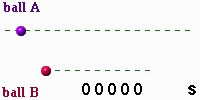Amplitude, Period and Frequency
Here is a ball moving back and forth with simple harmonic motion (SHM):

Its position x as a function of time t is:
x(t)=A⋅cos(2⋅π⋅tT)
where A is the amplitude of motion: the distance from the centre of motion to either extreme
T is the period of motion: the time for one complete cycle of the motion.
Questions
Which ball has a larger amplitude?
Ball A or Ball B
Ball A - Correct!
Ball B - No. That is not correct
Which ball has a longer period?
Ball A or Ball B
Ball A - Correct!
Ball B - No. That is not correct
What is the period of Ball B?
A) 4.0s
B) 8.0s
C) 12 s
D) 16s
A) 4.0s - No. The period is the time for one full oscillation.
B) 8.0s - No. The period is the time for one full oscillation.
C) 12 s - Correct!
D) 16s - No. The period is the time for one full oscillation.
The frequency of motion, f, is the rate of repetition of the motion -- the number of cycles per unit time. There is a simple relation between frequency and period: f=T−1
What is the frequency of ball B (recall, the period is 12s)?
A) 0.0625 Hz
B) 0.0833 Hz
C) 0.125 Hz
D) 0.250 Hz
A) 0.0625 Hz - No. Remember f=1/T
B) 0.0833 Hz - Correct!
C) 0.125 Hz - No. Remember f=1/T
D) 0.250 Hz - No. Remember f=1/T
Angular frequency is the rotational analogy to frequency. Represented as , and is the rate of change of an angle when something is moving in a circular orbit. This is the usual frequency (measured in cycles per second), converted to radians per second. That is ω=2π/T=2πf
Which ball has the larger angular frequency?
Ball A or Ball B
Ball A - No. ω is proportional to f
Ball B - Correct!
What is ball B's angular frequency?
A) 0.125πrads−1
B) 0.167πrads−1
C) 0.250πrads−1
D) 0.500πrads−1
A) 0.125πrads−1 - No. ω=2pf
B) 0.167πrads−1 - Correct!
C) 0.250πrads−1 - No. ω=2pf
D) 0.500πrads−1 - No. ω=2pf

From this graph, find the following:
| 1. Amplitude (A) | 2. period (T) | 3. frequency (f) | 4. angular frequency (ω) |
|---|---|---|---|
| A) 20 cm | A) 0.20 s | A) 0.20 Hz | A) 0.20πrads−1 |
| B) 1.0 cm | B) 1.0 s | B) 1.0 Hz | B) 1.0πrads−1 |
| C) 5.0 cm | C) 5.0 s | C) 5.0 Hz | C) 5.0πrads−1 |
| D) 10 cm | D) 10 s | D) 10 Hz | D) 10πrads−1 |
- amplitude (A):
A) 20 cm - No. It is not the distance from a crest to a trough.
B) 1.0 cm - No. That is not correct.
C) 5.0 cm - No. That is not correct.
D) 10 cm - Correct!
- period (T):
A) 0.20 s - Correct!
B) 1.0 s - No. The period is the time for one full oscillation.
C) 5.0 s - No. The period is the time for one full oscillation.
D) 10 s - No. The period is the time for one full oscillation.
- frequency (f):
A) 0.20 Hz - No. The frequency is 1/T
B) 1.0 Hz - No. The frequency is 1/T
C) 5.0 Hz - Correct!
D) 10 Hz - No. The frequency is 1/T
- angular frequency (ω):
A) 0.20πrads−1 - No. ω=2πf
B) 1.0πrads−1 - No. ω=2πf
C) 5.0πrads−1 - No. ω=2πf
D) 10πrads−1 - Correct!